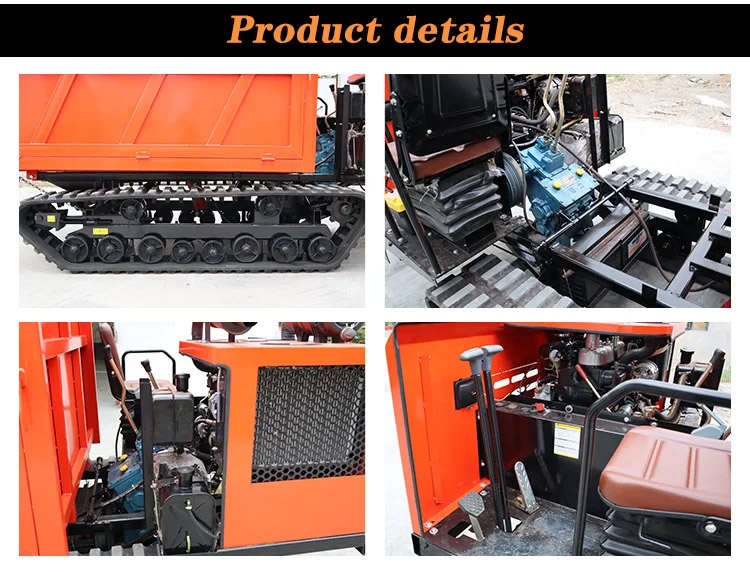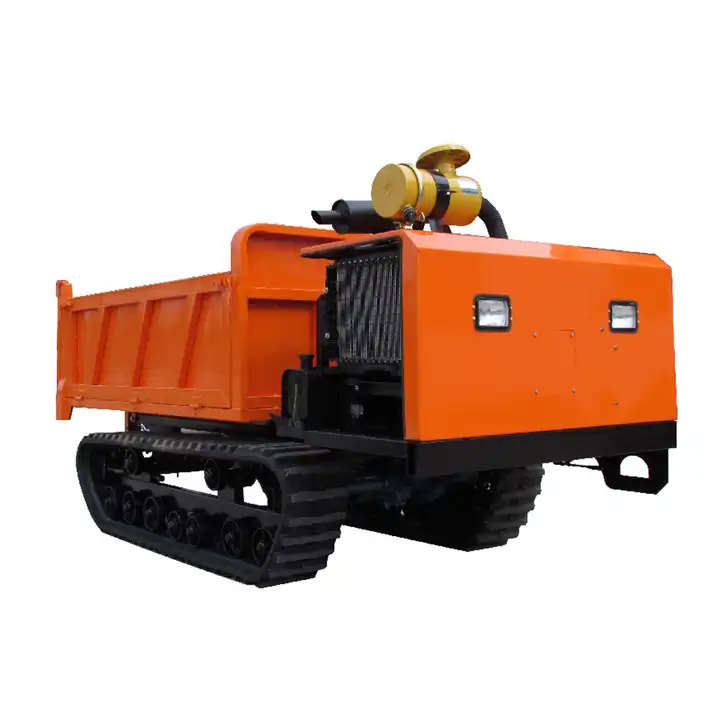- Home >
- Product >
- Loaders >
- Crawler Dumper >
- View Details
Supply 1.5T Crawler Trucked Carrier spots
Tracked transport vehicles, often referred to as tracked vehicles or caterpillar-tracked vehicles, are a remarkable category of vehicles that offer exceptional mobility and versatility.
- 1.5T
- ZHUOXIN
- Crawler Trucked Carrier
- shandong.china
- TT, Paypal, Credit card, Western union
- +86-15163766288
- Traction and Stability: Tracked vehicles excel in off-road conditions, including rough terrain, mud, snow, and swamps, thanks to their superior traction and stability.
Description

Tracked transport vehicles, often referred to as tracked vehicles or caterpillar-tracked vehicles, are a remarkable category of vehicles that offer exceptional mobility and versatility. Unlike traditional wheeled vehicles, these machines utilize a track system, which consists of a continuous belt of interconnected metal or rubber tracks. This design provides numerous advantages, making tracked transport vehicles essential in various industries and applications. In this article, we will explore the features, types, and applications of tracked transport vehicles in detail.

Features of Tracked Transport Vehicles:
Traction and Stability: Tracked vehicles excel in off-road conditions, including rough terrain, mud, snow, and swamps, thanks to their superior traction and stability. The distribution of weight over a larger contact area minimizes the risk of getting stuck or bogged down.
Load Capacity: Tracked transport vehicles come in various sizes and configurations, allowing them to carry heavy loads efficiently. From military tanks to construction equipment, these vehicles can transport substantial payloads.

Low Ground Pressure: Due to the even weight distribution on their tracks, tracked vehicles exert low ground pressure. This feature makes them suitable for use in environmentally sensitive areas, such as wetlands or fragile ecosystems, where minimizing ground disturbance is crucial.

Versatile Attachments: Many tracked vehicles can be customized with different attachments and equipment, making them adaptable for a wide range of tasks. These attachments can include bulldozer blades, excavator arms, and cargo containers.
Types of Tracked Transport Vehicles:
Tracked transport vehicles can be categorized into several types, each designed for specific purposes:
Tanks: Military tanks are perhaps the most well-known tracked vehicles. They are heavily armored and armed, designed for combat operations. Modern tanks feature advanced technology, including composite armor and powerful weapons systems.

Construction Equipment: Tracked transport vehicles are commonly used in the construction industry. Excavators, bulldozers, and compact track loaders are examples of heavy machinery that rely on tracks for stability and maneuverability.
Agricultural Machinery: Some agricultural equipment, such as combine harvesters and tractors, use tracks instead of wheels. This design reduces soil compaction and enhances traction in fields.

Snow Vehicles: Snow groomers and snowcats are tracked transport vehicles used in winter sports resorts for maintaining ski slopes and transporting personnel and equipment in snowy conditions.

Forestry Vehicles: Tracked skidders and forwarders are utilized in forestry operations to extract and transport timber from remote or challenging terrains.
Applications of Tracked Transport Vehicles:
Tracked transport vehicles find applications in various industries and scenarios, including:
Military: Tanks and armored personnel carriers are used for defense and combat operations.
Construction: Excavators, bulldozers, and cranes equipped with tracks are employed in building infrastructure.
Agriculture: Tracked tractors and harvesters help with farming tasks.
Mining: Heavy-duty tracked vehicles are used in mining operations for hauling ore and excavation.
Emergency Services: Some tracked vehicles are utilized by search and rescue teams in challenging environments.
Arctic Exploration: Tracked vehicles are used in polar regions for scientific research and exploration.
Conclusion:
Tracked transport vehicles represent a crucial element in various industries due to their exceptional mobility, load-bearing capacity, and adaptability. Whether on the battlefield, construction site, or agricultural field, these vehicles continue to play a vital role in challenging terrains and adverse conditions. Their unique design and versatility make them indispensable assets in a wide range of applications.

Features of Tracked Transport Vehicles:
Traction and Stability: Tracked vehicles excel in off-road conditions, including rough terrain, mud, snow, and swamps, thanks to their superior traction and stability. The distribution of weight over a larger contact area minimizes the risk of getting stuck or bogged down.
Load Capacity: Tracked transport vehicles come in various sizes and configurations, allowing them to carry heavy loads efficiently. From military tanks to construction equipment, these vehicles can transport substantial payloads.

Low Ground Pressure: Due to the even weight distribution on their tracks, tracked vehicles exert low ground pressure. This feature makes them suitable for use in environmentally sensitive areas, such as wetlands or fragile ecosystems, where minimizing ground disturbance is crucial.

Versatile Attachments: Many tracked vehicles can be customized with different attachments and equipment, making them adaptable for a wide range of tasks. These attachments can include bulldozer blades, excavator arms, and cargo containers.
Types of Tracked Transport Vehicles:
Tracked transport vehicles can be categorized into several types, each designed for specific purposes:
Tanks: Military tanks are perhaps the most well-known tracked vehicles. They are heavily armored and armed, designed for combat operations. Modern tanks feature advanced technology, including composite armor and powerful weapons systems.

Construction Equipment: Tracked transport vehicles are commonly used in the construction industry. Excavators, bulldozers, and compact track loaders are examples of heavy machinery that rely on tracks for stability and maneuverability.
Agricultural Machinery: Some agricultural equipment, such as combine harvesters and tractors, use tracks instead of wheels. This design reduces soil compaction and enhances traction in fields.

Snow Vehicles: Snow groomers and snowcats are tracked transport vehicles used in winter sports resorts for maintaining ski slopes and transporting personnel and equipment in snowy conditions.

Forestry Vehicles: Tracked skidders and forwarders are utilized in forestry operations to extract and transport timber from remote or challenging terrains.
Applications of Tracked Transport Vehicles:
Tracked transport vehicles find applications in various industries and scenarios, including:
Military: Tanks and armored personnel carriers are used for defense and combat operations.
Construction: Excavators, bulldozers, and cranes equipped with tracks are employed in building infrastructure.
Agriculture: Tracked tractors and harvesters help with farming tasks.
Mining: Heavy-duty tracked vehicles are used in mining operations for hauling ore and excavation.
Emergency Services: Some tracked vehicles are utilized by search and rescue teams in challenging environments.
Arctic Exploration: Tracked vehicles are used in polar regions for scientific research and exploration.
Conclusion:
Tracked transport vehicles represent a crucial element in various industries due to their exceptional mobility, load-bearing capacity, and adaptability. Whether on the battlefield, construction site, or agricultural field, these vehicles continue to play a vital role in challenging terrains and adverse conditions. Their unique design and versatility make them indispensable assets in a wide range of applications.
Tags
Get the latest price? We'll respond as soon as possible(within 12 hours)























